The January thaw in the Mid-Atlantic convinced me to switch gears last minute. Rather than taking a planned trip to Utah in early March, I decided to bolt out of here last weekend, hoping that ski conditions locally would be better later in the season. On the day of my arrival, February 4, 2006, the Canyons boasted a base of over 80 inches and lots of fresh snow. What is more, it was snowing when we arrived at Salt Lake City.
Convenience was the main reason I chose The Canyons. One can get to this resort on direct flights from Washington in four hours and twenty minutes. From Salt Lake City International Airport, it’s only 35 minutes by car or shuttle to The Canyons. In other words, one can be skiing at The Canyons in about the same time than it takes to drive to Snowshoe.
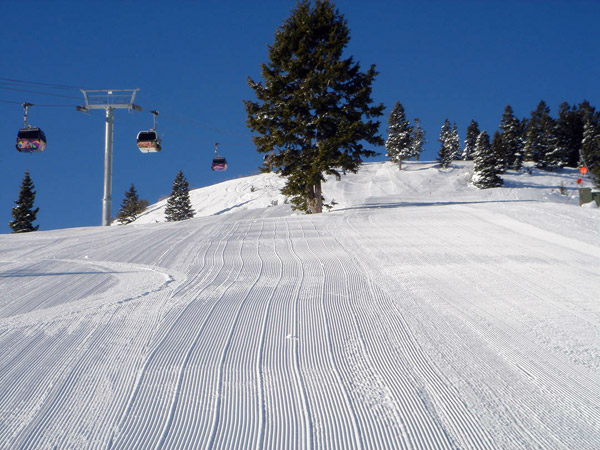
|
|
|
Another advantage of The Canyons is the area’s excellent free public transportation system. In this region, which also includes Park City Mountain Resort and Deer Valley, a car is more of a liability than an asset. Not only can parking in Park City be a hassle during the dinner hour and on weekends, but the roads can be treacherous in the snow. Case in point: we witnessed more car wrecks than we could count on the Saturday evening drive to the resort. Fortunately, we were in the good hands of an experienced shuttle driver from All Resort Express. The last thing one wants to confront after a long flight is a white knuckle drive in a subcompact rental car with no snow tires.
With 3,500 acres of skiable terrain and 16 lifts, The Canyons is Utah’s largest ski area and the fifth largest resort in North America. In three ski days, we barely sampled a third of the marked trails and almost never waited in a lift line. On Sunday, it snowed off and on, giving us powder conditions but also compelling us to earn our turns by skiing on ungroomed terrain covered in knee deep powder.
For the most part, we stuck to blue and double blue square terrain. The double blues were steeper than many double blacks here in the Mid-Atlantic! We found the most untracked snow off the Daybreak and Dreamscape chairs. The Dreamscape meadows proved particularly fun with steep terrain, small bumps, and very soft and forgiving snow. The fast and efficient lift system at The Canyons allowed me to get from one side of the area to the other in well under an hour.
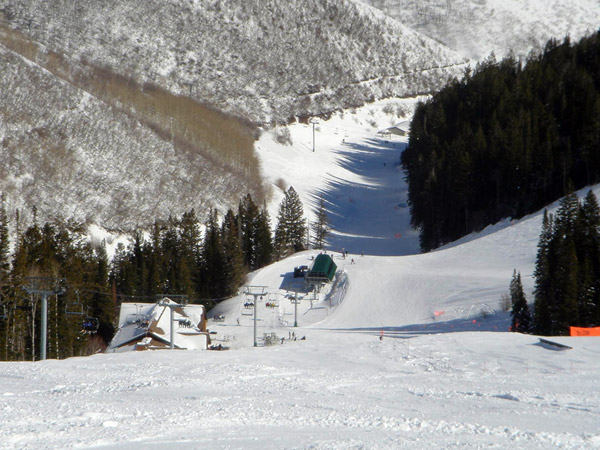
|
|
|
The next two days turned out to be classic blue birds -; clear skies and lots of perfectly groomed trails from which to choose. Among our favorites were Apex Ridge, Kestrel, and Arrow Head. The Canyons trail system is 14% beginner, 44% intermediate, and 42% expert. In truth, however, experts will find even more terrain off-piste “inbounds” and almost unlimited terrain off-piste “out-of-bounds.” For this reason, the Canyons might consider partially grooming some of its single black diamonds. The groomed sides of the trail would allow groups of mixed ability levels to ski together, and also permit advanced intermediates to taste some of the black terrain, knowing that a “paved” bail-out corridor would be available if needed. Such an option did exist for the blue Eclipse trail off the Sun Peak Express, but not on any of the blacks.
We stayed at the Sundial lodge in The Canyons base village. The Sundial offered large hotel-style rooms with some extras: sofas, refrigerators, microwaves, laundry machines (shared with the adjacent room), bathtubs with water jets, and an outdoor heated pool and hot-tub. More importantly, it was just 100 yards from the main access lift, the Flight of the Canyons 8-person gondola. We chose this lodge mainly for its access to the slopes, and in that regard, it lived up to its reputation, but the village itself turned out to be rather sterile and lacking in what the Austrian’s call, gemütlichkeit (coziness, a sense of belonging, and charm).
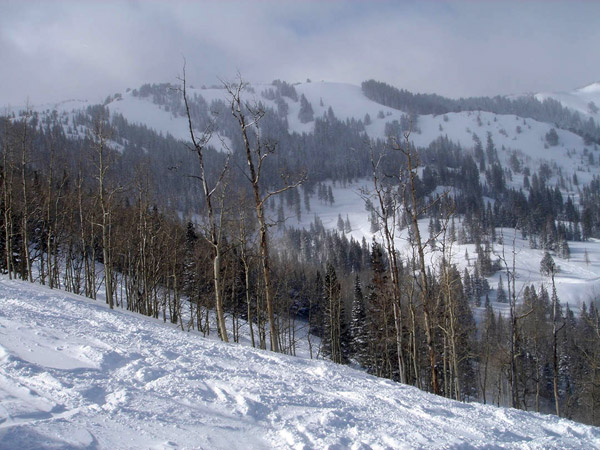
|
|
|
We ate breakfast daily at the Cabins Restaurant, an excellent venue that served up a four star quality breakfast buffet, but this was one of the few dining options in the village. The other major village restaurant, Doc’s, is a pub. As the village grows in size, I expect more restaurants will open, but in the meantime, visitors will need to travel to nearby Park City for additional choices.
For those like myself without wheels, there are three options for getting to Park City: a free shuttle run by Sundial and the Grand Summit Hotel; the free Park City Transit buses; and cabs, which cost approximately $15 one way to Main Street. The last hotel shuttle leaves Sundial at 5:05 pm, making the bus a more desirable transportation solution for dinner-goers. Transit buses run every 20 minutes from Canyons to Park City between 7:30 am to 10:30 pm. The ride takes twenty minutes.
When I got on one of these modern buses, I immediately noticed that 80 percent of the passengers were under twenty five and almost none of them were speaking English. Designed to move skiers around the region, the transit system also transports the resort’s large guest worker force, which comes mainly from Central and South America, Australia, New Zealand, and South Africa -; in short, places where college students on summer breaks can be found. I inferred from the lack of “guests” on the bus that many skiers either drive rental cars or take cabs to avoid riding with the hoi polloi. What a shame. Not only are these kids polite and friendly, but they represent a glimpse of the future of snow sports.
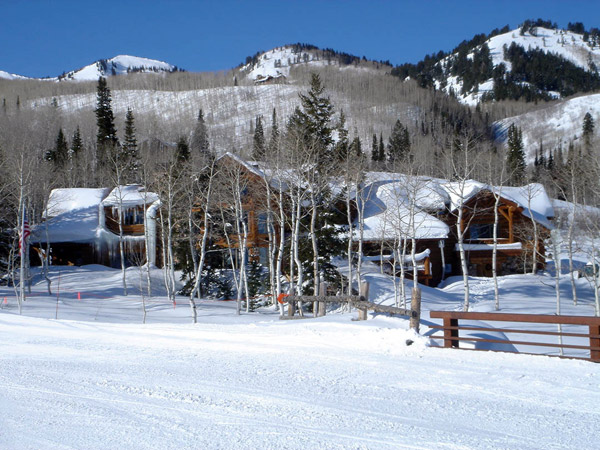
|
|
|
We ate at two places in Park City: an excellent Vietnamese venue called Saigon and a lackluster Mexican joint called La Casita. It’s easy to spend a lot of money eating out, but the town also boasts a fair number of moderately priced venues. Park City seems to cater to the Los Angeles jet set (think sushi and Asian fusion), but one can also find basic pizza and pub grub as well. For a ski town, Park City has a lot to offer, not just in terms of cuisine but for shopping as well. After dinner, I enjoyed poking around the town’s numerous art galleries, which feature some of the finest nature photography in the country.
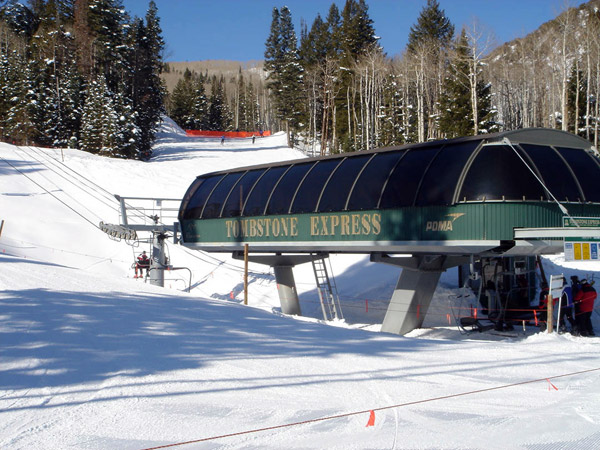
|
|
|
So were there any downsides? To be candid, the development at The Canyons seems a bit excessive. It’s hard to get across the base village without being accosted by someone trying to sell you a time-share. A cynical person might describe the place as one big housing development with a ski amenity, but that would be unfair since the vast majority of trails, at least for now, are devoid of houses or condos. However, if one looks at the future plans for the village closely, it becomes patently clear that the American Ski Company doesn’t want to build a town; it wants to develop a city the size of Reston with lots of upslope development. On the Dreamscape side of the resort, 13 million dollar houses are popping up like mushrooms and down in the village, foundations are in place for huge, multi-story, condo developments. If this development pays for the high-speed lifts and endless terrain, so be it, but I hope the resort can keep most of the ski terrain looking natural in appearance.
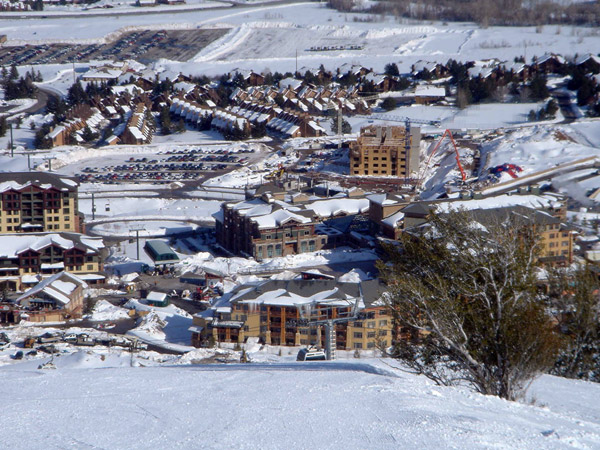
|
|
|
Another complaint is the lack of slope-side amenities. To be surrounded by the multi-million dollar homes of the Colony Development, and have to use a porto-toilet is degrading and absurd. Furthermore, while the snow and skiing at The Canyons rivaled some of the best I have experienced in the Alps, the mountain dining, while slightly better than most resorts here in the Mid-Atlantic, was disappointing. In Europe, a fine, affordable meal in cozy hut can be found at every lift station, but the Canyons offers just three indoor, on-mountain dining options: the crowded Pine Lodge at the top station of the Flight of the Canyons gondola; Lookout Cabin, a sit-down restaurant with waiters; and the Sundial Lodge. With its sunny outside deck, decent grill, and low crowds, we preferred the Sundial Lodge to all other places.
With these few criticisms aside, I would give our short ski vacation at Canyons a grade of 8.5 out of a scale of ten. The skiing certainly had soul and offered everything from terrifying steeps to broad, corduroy-lined groomers. The in-bounds off-piste was some of the best I’ve ever seen. Furthermore, high-speed lifts make it easy to rack up 15,000 feet of vertical in a morning without even trying. With just 14 percent of the terrain marked green, beginners may find the resort a bit challenging but experts and intermediates will find ample variety and the “greatest snow on earth.” Finally, the convenience of the place for DC area skiers is unsurpassed: nowhere in this country will you find better skiing closer to home than in the Park City region of Utah.
All photos provided by John Sherwood.
Mountain Chickadee, Poecile gambeli.
John Sherwood is a columnist for DCSki. When he's not hiking, biking, or skiing, he works as an author of books on military history.